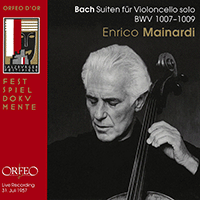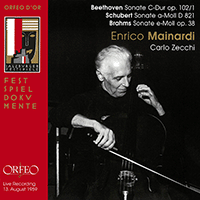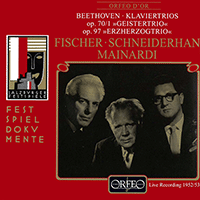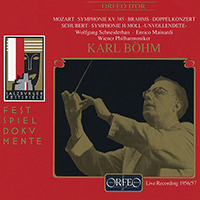Enrico Mainardi
Enrico Mainardi began cello lessons at the age of four. By the time he was eight he had publicly performed a Beethoven sonata and was launched as a child prodigy by his father, rather in the manner of Mozart. At thirteen he gave his London première in a Promenade concert conducted by Henry Wood and three years later is said to have captivated a Heidelberg audience at the Bach-Reger Festival with Bach’s Cello Suite in C.
World War I halted Mainardi’s touring for four years, precipitating a re-evaluation of his musicianship. He went to Rome’s Accademia di Santa Cecilia to study composition and piano, not daring to retrain on the cello until 1924. He then studied at the Berlin Hochschule with Hugo Becker, relearning all he had previously known and relaunching his solo career. In 1941, in fact, he succeeded Becker at the Berlin Hochscule, becoming known primarily as a teacher with a talent for spotting and, crucially, remedying bad habits and mental blocks in young players.
As a soloist his career in maturity took a long time to be fully established, particularly in France and England in the years after World War II. His interpretative philosophy was conservative and steeped in nineteenth-century ideals: he taught that the whole score of a piece should be fully appraised before performance was attempted and that the melodic outlines should be dictated by the underlying harmonic movement. This conservatism extended to his calm on-stage persona (in an age of increasingly conspicuous expressivity), although he is said to have entertained the eccentricity of dressing to suit the music being performed.
Allowance must be made for the age of some of these recordings, and indeed the subsequent change in performance priorities. At first hearing his famous live 1949 Brahms Double Concerto with Schneiderhan under Furtwängler may seem rather clumsy, but both soloists deliver intent and committed performances here. Mainardi’s tone is stylistically quite restrained: his portamento is generally fast and light, whilst vibrato, although frequent, is relatively discreet. Unfortunately this can result in some rather strained tone in his Haydn Concerto in D (1950), which suffers from over-legato phrasing and somewhat ‘dug-out’ tone which is not always stable in intonation, but this recording is in many ways typical of its time: the concerto was not particularly fashionable and it was long before the revival of historical performing practices brought it to the fore once again. The same might be said of Boccherini’s Sonata No. 6 (1952), which again suffers from from insufficiently varied phrasing and tone: an approach now outmoded. In Romantic repertoire, however, such as his restrained and generally Olympian readings of Brahms’s Op. 38 Sonata (1952) and the Dvořák Concerto (1950), Mainardi becomes an important figure of his time, perpetuating nineteenth-century aesthetic values by then unfashionable for many musicians.
© Naxos Rights International Ltd. — David Milsom (A–Z of String Players, Naxos 8.558081-84)
























